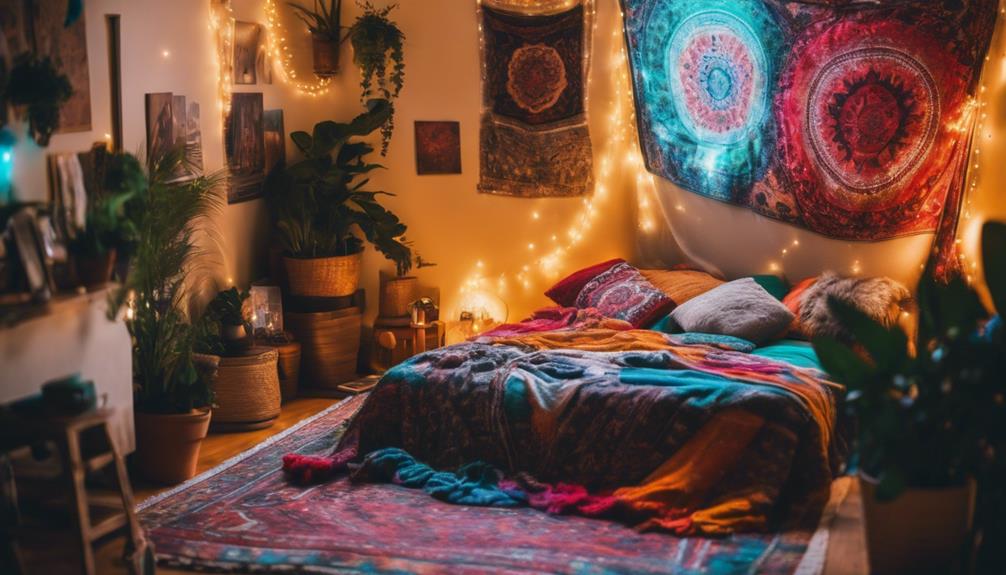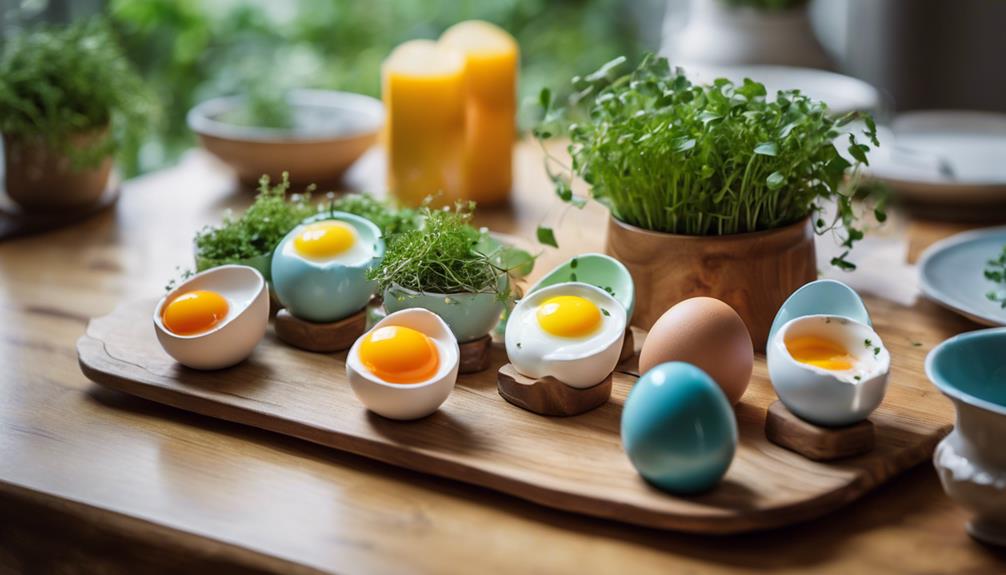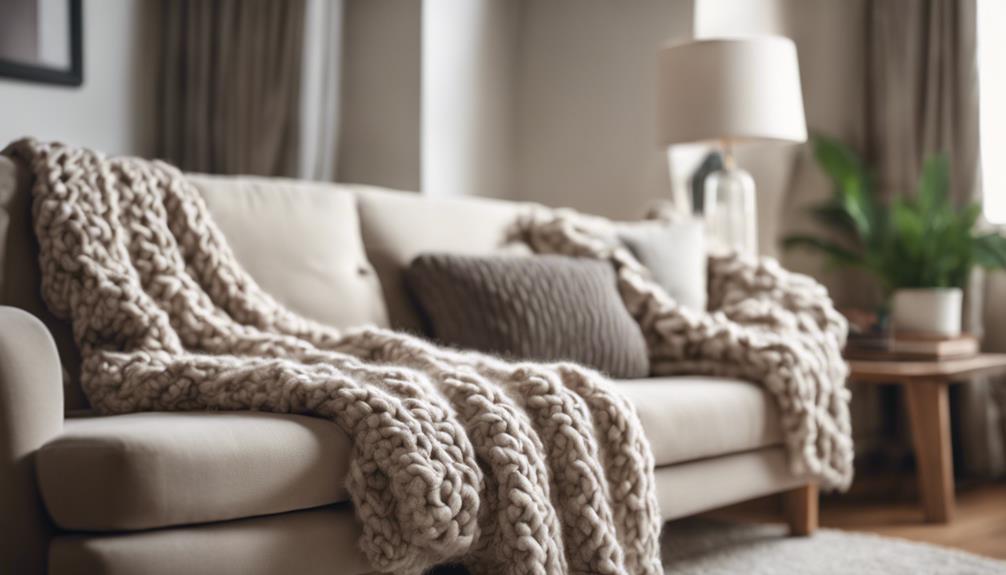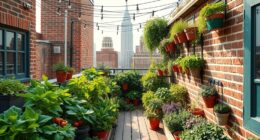Art Hoe room decor is all about vibrant colors and eclectic elements that breathe creativity into your space. Start with primary colors to energize the atmosphere, complemented by soft pastels for balance. Incorporate vintage easels to showcase your artwork and bohemian floor cushions for relaxed seating. Layer textures with plush throws and macramé wall hangings for an artsy vibe. Don't forget cozy fairy lights to enhance the ambiance! Personal touches like hand-painted pottery and colorful tapestries will truly reflect your style. Keep exploring for even more unique ideas that'll make your room a standout artistic haven.
Key Elements
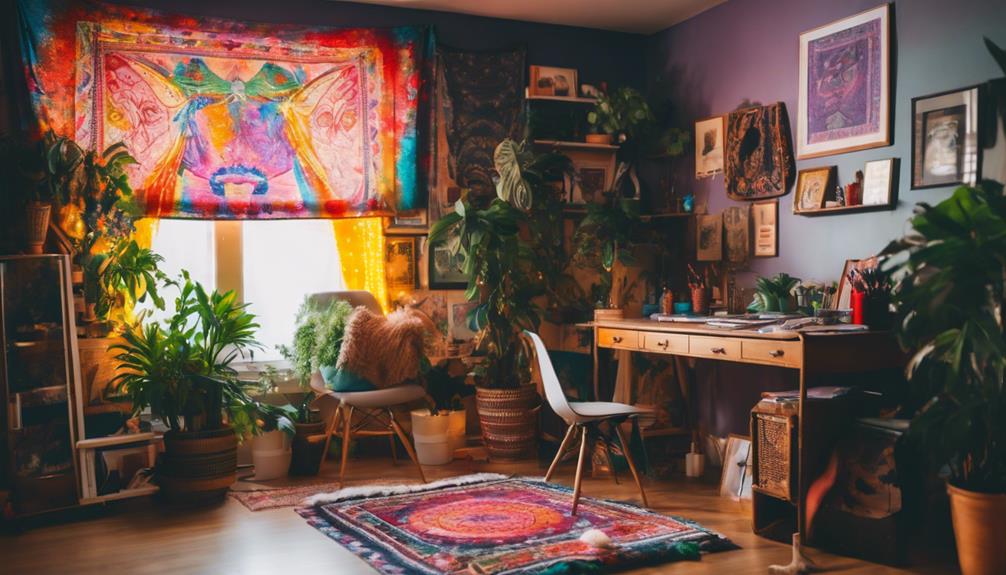
When creating your Art Hoe room, focus on the vibrant color scheme that energizes the space.
Use a mix of materials and textures to add depth and interest to your decor.
These key elements will help you express your unique style and love for creativity.
Color Scheme
To create an art hoe room decor, focus on a vibrant color scheme that incorporates primary colors like yellow, red, blue, and green to ignite creativity and symbolize nature. This lively color palette is vital for achieving that bold art hoe aesthetic you're aiming for. You can also enhance the impact of these vibrant hues by using lighter wall colors like white or beige, which help your decor elements stand out.
While it's perfectly acceptable to incorporate all colors of the rainbow, balance is significant. Make sure brighter accents elevate the room's overall vibrancy without overwhelming the senses. If you prefer a softer touch, consider pastel tones like light blue and pale yellow, which can provide a revitalizing twist within the art hoe theme.
For a cohesive look, coordinating one or two foundational colors throughout your decor can create a visually appealing atmosphere. This way, you'll maintain the energy of the art hoe aesthetic while ensuring your space feels inviting and well-thought-out.
Embrace your creativity, and let your color choices reflect your personality!
Materials
Key materials for your Art Hoe room decor include vibrant acrylic paints and Copic markers, allowing you to release your creativity and personalize your space. These tools are essential for creating unique art pieces that reflect your personality and style.
Incorporating natural elements like pressed flowers and potted plants can enhance your decor, bringing a revitalizing touch of nature indoors. Vintage picture frames and mirrors not only add visual interest but also create depth, making your wall displays more engaging.
Consider adding rustic or delicately painted furniture, such as trestle tables and movable hanging racks, to contribute to the overall artsy vibe of your room. These pieces can serve as functional storage while also showcasing your art creations.
Lastly, vibrant textiles like botanical and floral patterned bedding, accent pillows, and throws can create a cozy atmosphere that complements the Art Hoe aesthetic. These materials work together to create a harmonious and inviting space, perfect for expressing your artistic flair.
Embrace these elements to transform your room into a creative sanctuary that impresses everyone who enters!
Textures
Textures greatly enhance the Art Hoe aesthetic, adding depth and sensory richness to your room decor. To create a truly immersive atmosphere, mix various materials like soft fabrics for bedding, rough canvases for your wall decor, and smooth ceramics for vases. This combination results in a rich sensory experience that invites comfort and creativity.
Incorporate natural textures by using woven baskets for plant displays and wooden furniture to emphasize the organic feel of your space. Layering different textures, such as plush throw blankets and knitted pillows, not only adds warmth but also makes your room feel inviting and cozy.
Don't forget to integrate textured wall decor, like tapestries or framed pressed flowers, to create visual interest and break the monotony of flat surfaces. Aim for balance; combining soft items with harder elements, such as metal or glass decor, guarantees your room feels dynamic and well-rounded.
Essential Fixtures and Furniture
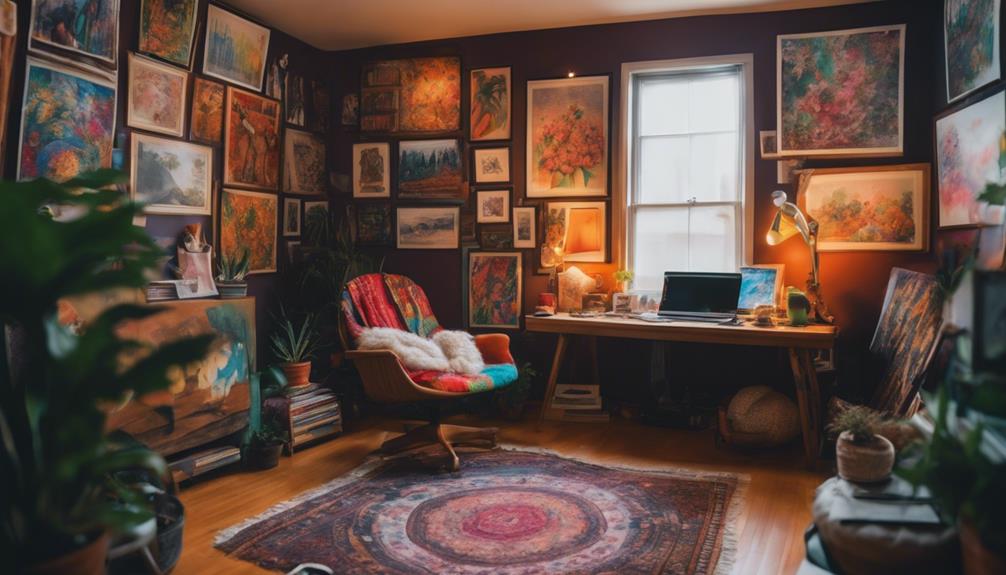
To truly embrace the art hoe aesthetic, you'll want to incorporate a vintage easel for displaying your artwork and inspiring creativity.
Adding bohemian-style floor cushions not only provides extra seating but also creates a cozy vibe perfect for art sessions.
Vintage Easel for Artwork
A vintage easel not only showcases your artwork beautifully but also adds a charming touch to your art hoe-inspired room. By opting for a wooden or distressed metal easel, you can enhance the rustic vibe that complements the artistic aesthetic of your decor. This fixture serves a dual purpose; it doesn't just display your art but also provides a creative workspace where you can paint or sketch.
Using a vintage easel allows you to highlight your favorite pieces, whether they're botanical prints or abstract art, adding a personal touch to your space. The easel's presence can also help harmonize the overall color palette in your room, especially when you incorporate primary colors and natural tones typical of the art hoe style.
When friends visit, they'll appreciate the unique charm that a vintage easel brings to your decor, making your artwork a focal point. It fosters a creative atmosphere that encourages inspiration and artistic expression, perfectly aligning with the vibe you want to create in your art hoe room.
Bohemian-Style Floor Cushions
How can bohemian-style floor cushions transform your Art Hoe room into a cozy and inviting space? These cushions are essential fixtures that bring warmth and character to your environment.
Featuring vibrant patterns and rich textures, they align perfectly with the Art Hoe aesthetic's love for color and nature. Not only do bohemian-style floor cushions provide functional seating, but they also serve as decorative elements that reflect your personality.
With tassels, embroidery, and unique prints, they enhance the visual appeal of your room while inviting creativity. Ideal for gathering spaces, these cushions encourage social interaction and a relaxed vibe.
You can easily arrange them in various configurations, allowing for versatile seating and a sense of community. Plus, many cushions are made from natural materials, making them eco-friendly and aligning with your appreciation for nature.
Available in multiple sizes and shapes, you can mix and match to create a personalized layout. This customization helps showcase your individual style, making your Art Hoe room not just a living space, but a cozy and inviting atmosphere that impresses everyone who enters.
Macramé Wall Hanging
Macramé wall hangings elevate your Art Hoe room decor with their intricate designs and natural textures, creating a stunning focal point that captures attention. These decorative pieces not only enhance your space but also foster a strong connection to nature, which is central to the Art Hoe aesthetic.
Made from organic materials like cotton or jute, macramé wall hangings reflect your appreciation for sustainable elements. They can transform a neutral wall into a vibrant display, drawing the eye and adding depth to your room. You can choose from various styles and sizes, allowing for endless personalization and creativity in your wall decor.
Pair your macramé hangings with plants or other artistic elements to create a cohesive and inviting atmosphere. The interplay between the textures of the macramé and the greenery can elevate the overall vibe of your space.
Whether you opt for a large statement piece or a collection of smaller hangings, macramé wall decor provides a warm, bohemian touch that resonates with your artistic spirit and enhances your connection to nature.
Embrace this trend to impress everyone who steps into your Art Hoe haven!
Lighting Ideas

Lighting plays an essential role in setting the mood for your art hoe room.
You can create a magical vibe with fairy lights draped overhead or opt for colorful neon floor lamps to make a bold statement.
Artistic pendant light fixtures and table lamps with vibrant shades can also enhance the aesthetic while illuminating your space beautifully.
Fairy Lights Draped Overhead
Draping fairy lights overhead instantly transforms your space, adding a cozy ambiance that enhances the vibrant colors typical of Art Hoe decor. These soft, glowing lights create a warm and inviting atmosphere, making your room feel more artistic and alive. You can easily drape them along the ceiling, around furniture, or even across walls to add depth and dimension to your decor.
Choose between warm white or colorful fairy lights to complement the primary colors—yellow, red, blue, and green—that are staples of the Art Hoe aesthetic. LED fairy lights are particularly great since they're energy-efficient and come in various styles, like string, icicle, or globe, allowing you to express your creativity.
To elevate the artistic vibe of your space even further, consider incorporating fairy lights with other decor elements, such as plants and artwork. This combination not only enhances your room's overall look but also creates a more immersive environment.
Colorful Neon Floor Lamps
Colorful neon floor lamps can instantly elevate your art hoe room by adding vibrant pops of color that draw the eye and enhance your creative space. These lamps serve as striking focal points, making them perfect for showcasing your unique style. With various shapes and designs available, you can easily find a lamp that reflects your passion for art and nature.
Incorporating colorful neon floor lamps creates a warm and inviting atmosphere, especially when paired with fairy lights or candles. You'll find that these lamps harmonize beautifully with your room's primary color palette, complementing yellows, reds, blues, and greens. The right neon lamp not only illuminates your space but also adds an artistic flair that resonates with your aesthetic.
Many of these lamps are energy-efficient LED options, allowing you to light up your creative sanctuary sustainably. Whether you place one in a corner or use multiple lamps throughout the room, colorful neon floor lamps will enhance your vibe, making your art hoe room a true reflection of your personality and creativity.
Elevate your space and inspire your artistic endeavors with these vibrant lighting choices!
Artistic Pendant Light Fixture
An artistic pendant light fixture can transform your space, adding both style and functionality while complementing the vibrant ambiance created by colorful neon floor lamps. These fixtures serve as focal points in your Art Hoe room, enhancing the overall look with unique designs that reflect your personal style.
You can choose from various materials like glass, metal, or wood, allowing you to curate an aesthetic that ranges from modern to rustic. When selecting a pendant light, opt for one that emits a warm glow; this creates an inviting atmosphere perfect for highlighting artwork and decorative elements throughout your space.
The versatility of pendant lights is another advantage. They come in various shapes and sizes, from geometric designs to floral motifs, enabling you to customize your decor to resonate with the Art Hoe aesthetic. Additionally, incorporating pendant lighting with adjustable heights can further enhance your room's mood, allowing you to create different vibes effortlessly.
Artistic Table Lamp With Colorful Shade
Bringing in an artistic table lamp with a colorful shade can instantly elevate your Art Hoe room, serving as a vibrant accent that ties together your creative decor. This lamp can become a focal point, enhancing the lively color palette usually found in Art Hoe aesthetics, which often includes bold primary colors like yellow, red, and blue.
When selecting your artistic table lamp, look for unique designs that showcase floral patterns or abstract shapes. These features complement the nature-inspired decor that's popular in this style. Additionally, the warm lighting from the lamp creates an inviting atmosphere, especially when paired with fairy lights or LED strips, guaranteeing a cozy ambiance.
The colorful shade of your lamp can reflect your personal interests, whether through artistic motifs or colors that resonate with your creative expression. As you choose an artistic table lamp, consider how it aligns with other elements in your room, like bedding and wall decor, to guarantee a cohesive and harmonious overall look.
With the right lamp, you'll enhance not just the lighting, but the entire vibe of your Art Hoe sanctuary.
Decorative Elements
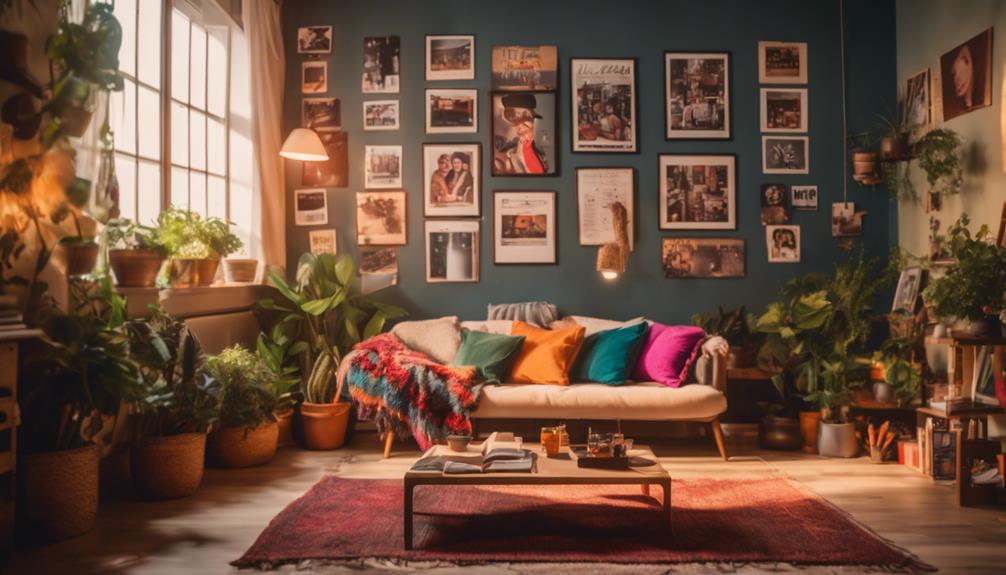
When it comes to decorative elements, you'll want to choose pieces that reflect your unique style and enhance your space.
Hand-painted ceramic plant pots bring a personal touch, while a colorful tapestry wall hanging can serve as a bold focal point.
Framed vintage art prints add character and charm, tying your art hoe aesthetic together beautifully.
Hand-Painted Ceramic Plant Pots
Hand-painted ceramic plant pots instantly elevate your Art Hoe room decor with their vibrant colors and unique designs. These pots add a personal touch, making your space feel more inviting and creative. Often adorned with artistic patterns, they celebrate individuality, perfectly aligning with the Art Hoe aesthetic that embraces visual arts.
Incorporating plants in hand-painted pots not only beautifies your room but also emphasizes your connection to nature—an essential element of the Art Hoe style. The durability of ceramic guarantees that these pots will last while offering a variety of textures and finishes that enhance your decor's overall look.
When selecting your hand-painted ceramic plant pots, consider choosing ones in primary colors like yellow, red, and blue. These colors can complement your room's existing palette, creating a cohesive and harmonious atmosphere. You can mix and match different designs and sizes to create an eye-catching display that reflects your artistic personality.
Colorful Tapestry Wall Hanging
Colorful tapestry wall hangings can transform your Art Hoe room, adding striking focal points that showcase vibrant designs and artistic expression. These tapestries often feature eye-catching motifs like florals, abstract art, or landscapes, enhancing the dynamic atmosphere of your space. When you hang a colorful tapestry against neutral-colored walls, it creates a stunning contrast that allows the hues to pop and energize the entire room.
Not only do these tapestries serve as decor, but they can also function as lightweight room dividers or backdrops for your art displays, making them incredibly versatile options. Whether you want to create a cozy nook or highlight your creative collections, a colorful tapestry can do the trick.
With price points typically ranging from $21.99 to $25.40, adding a colorful tapestry to your decor is an affordable way to infuse personality and artistic flair into your room. So, why not choose one that resonates with your style? It's a simple yet impactful way to elevate your Art Hoe aesthetic and impress everyone who enters your space.
Framed Vintage Art Prints
Framed vintage art prints infuse your Art Hoe room with a charming blend of nostalgia and eclectic style, making them essential decorative elements. These prints come in various styles, from botanical illustrations to abstract designs, and even classic pieces from renowned artists. By incorporating these framed vintage art prints, you enhance the artistic vibe of your space and create a unique atmosphere that resonates with the art hoe aesthetic.
To truly make a statement, consider mixing different vintage frames in various styles and colors. This approach can create a visually interesting gallery wall that showcases your personal taste and creativity. You can easily customize your decor to reflect your individuality and interests, a core principle of the art hoe aesthetic.
Don't forget to mix in other decor elements, like Polaroid photos and plants. Combining framed vintage art prints with these items fosters a harmonious and inviting atmosphere, perfectly embodying the spirit of art hoe living.
Flooring
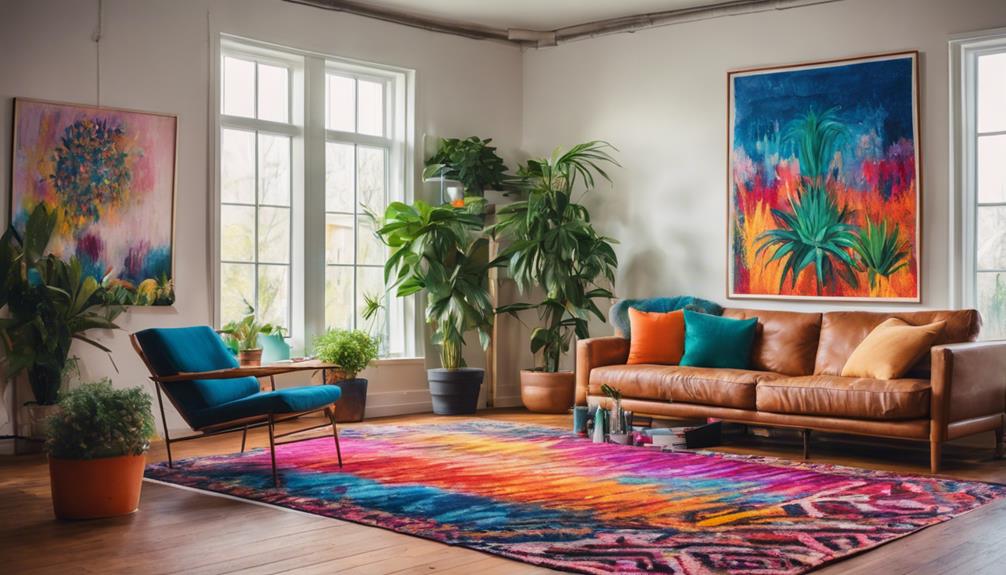
When it comes to flooring in your Art Hoe room, reclaimed wood plank flooring offers a rustic charm that adds warmth to your space.
You might also consider textured area rugs to bring in color and comfort while defining different areas.
For a bold statement, brightly colored painted concrete can create a unique foundation that reflects your artistic vibe.
Reclaimed Wood Plank Flooring
Reclaimed wood plank flooring brings an eco-friendly charm to your art hoe room, enhancing its unique character with every distinct texture and hue. This sustainable choice not only reduces waste but also adds warmth and personality to your space. Each plank showcases variations in grain patterns and colors, perfectly complementing the vibrant palettes typical of the art hoe aesthetic.
When you install reclaimed wood, you create a rustic and artistic vibe that aligns with your love for nature and creativity. The durable nature of reclaimed wood means it can easily withstand the wear and tear of an artistic environment, making it a practical option for your creative endeavors. Plus, its unique characteristics guarantee that your flooring stands out, supporting the eclectic and personalized decor elements that define the art hoe style.
Incorporating reclaimed wood plank flooring helps you establish a stylish foundation in your room, setting the stage for further artistic expression. So, if you're looking to elevate your space while keeping sustainability in mind, reclaimed wood is the way to go, making your art hoe room truly one-of-a-kind.
Textured Area Rugs
Textured area rugs instantly transform your art hoe room, adding warmth and comfort while enhancing the inviting atmosphere with their tactile appeal. These rugs come in various materials, with natural fibers like jute and wool being popular choices that align perfectly with your nature-inspired aesthetic.
Incorporating textured area rugs with vibrant primary colors or botanical and floral patterns can truly elevate your space. These designs not only reinforce the Art Hoe vibe but also create a visual connection with your plants and artwork. Layering these rugs over neutral flooring can add depth and interest, making the room feel more dynamic and cozy.
Textured rugs also help define specific areas in your room, like a reading nook or workspace, showcasing your personal style. When selecting a rug, consider how its color and texture will complement your overall decor.
Whether you opt for a bold, patterned piece or a more subtle texture, the right rug can tie your room together beautifully. Embrace the comfort and aesthetic appeal of textured area rugs, and watch as they enhance the inviting charm of your art hoe sanctuary.
Brightly Colored Painted Concrete
Brightly colored painted concrete flooring serves as a stunning canvas that enhances the Art Hoe aesthetic, creating a vibrant backdrop for your artistic expression. This flooring option allows you to customize your space with unique designs, like geometric patterns or abstract art, reflecting your individual style and creativity.
Durable and easy to maintain, brightly colored painted concrete is a practical choice for any artistic space, while still delivering a visually striking appearance. You can incorporate primary colors like yellow, red, and blue into your concrete design, creating a cohesive look that harmonizes beautifully with other decorative elements in your Art Hoe room.
Moreover, the use of brightly colored concrete flooring contributes greatly to the overall warmth and inviting atmosphere of the room. It sets the perfect foundation for art and nature-inspired decor, allowing your creativity to flourish.
Whether you're hosting friends or simply enjoying your own space, this flooring choice will impress everyone. So, if you're looking to elevate your room's aesthetic, consider embracing the charm and vibrancy of brightly colored painted concrete for a truly artistic environment.
Conclusion
Incorporating art hoe decor into your room is all about expressing your unique style and creativity.
By choosing the right fixtures, lighting, and decorative elements, you can create a vibrant and inspiring space that reflects your personality.
Don't forget to play with flooring options to enhance the overall aesthetic.
With these ideas, you're sure to impress everyone who steps into your room.
So, release your artistic side and transform your space into a true masterpiece!
